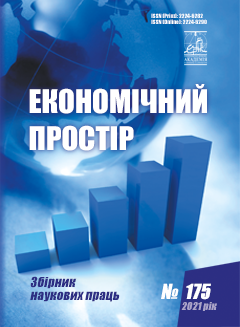PROSPECTS OF APPLICATION OF DSGE-MODELS FOR FORMATION OF THE COUNTRY DEVELOPMENT STRATEGY
Abstract
The purpose of the study is to find Ukraine's way out of the socio-economic crisis and to form a development strategy based on economic and mathematical modeling using macroeconomic DSGE models (Dynamic Stochastic General Equilibrium).The contradictions facing public administration have intensified against the background of quarantine measures against the COVID-19 pandemic. The economic and political contradictions of the macrosystem of Ukraine are revealed.The state must minimize the negative economic implications of restrictions on social and economic activity. The emphasis on the peculiarities of the economic, political and social situation in Ukraine is made. It is shown that conducting generally accepted measures to improve the situation and forming a strategic direction of development faces opposition. The solution to the problem is appropriate to obtain on the basis of economic and mathematical modeling and solving a dynamic stochastic multicriteria problem of conditional optimization with many variables. It is proposed to apply tools for macroeconomic dynamic stochastic models of general equilibrium (DSGE). The language of mathematics this means that before the countries there is a dynamic multicriteria problem of conditional optimization with many variables. The prospects for using DSGE models to form a country's development strategy are considered in detail. The theoretical foundations of these models are the integration of neo-Keynesian and neoclassical approaches. It is shown that DSGE models allow you to combine macroeconomic policy of the state with the opposite interests of diverse groups of economic agents. The advantages and disadvantages of the benefits of dynamic stochastic models of general equilibrium are shown. DSGE models can be used for retrospective analysis, forecasting the future and finding out factors of such events, EX ANTE scenario analysis. It is possible to apply them to simulate stochastic price, technological, monetary, etc. "shocks". The country will be able to solve the decision-making problem in conditions of uncertainty and choose its optimal development and crisis strategy.
References
Adolfson M. Laseen S., Linde J., VillaniM. Bayesian estimation of an open economy DSGE model with incomplete pass-through. Journal of International Economics. 2007. Vol. 72. № 2. P. 481–511.
Altig D., Christiano L.J., Eichenbaum M., Linde J. Firm-specific capital, nominal rigities and the business cycle. Review of Economic Dynamics. 2011. Vol. 14. № 2. P. 225–247.
Aruoba B., Cuba-Borda P., Schorfheide F.. Macroeconomic Dynamics Near the ZLB: A Tale of Two Countries. Manuscript. 2016.
Baxter M., King R.G. Fiscal policy in general equilibrium. American Economic Review. 1993. Vol. 83. № 3. P. 315–334.
Calvo G.A.Staggered prices in a utility-maximizing framework. Journal of Monetary Economics. 1983. Vol. 12. P. 383–398.
Canova F. Methods for applied macroeconomic research. Princeton University Press.
Smets F., Wouters R. An estimated dynamic stochastic general equilibrium model of the Euro Area. Journal of European Economic Association. 2003. Vol. 1. № 5. P. 1123–1175.
Smets F., Wouters R. Shocks and frictions in US business cycles: a Bayesian DSGE approach. American Economic Review. 2007. Vol. 97. № 3. P. 586–606.
Adolfson M. Laseen S., Linde J., VillaniM.(2007). Bayesian estimation of an open economy DSGE model with incomplete pass-through. Journal of International Economics. vol.72. no2,pp.481–511.
Altig D., Christiano L.J., Eichenbaum M., Linde J. (2011) Firm-specific capital, nominal rigities and the business cycle // Review of Economic Dynamics. vol. 14. no 2,pp. 225–247.
Aruoba B., Cuba-Borda P., Schorfheide F. (2016). Macroeconomic Dynamics Near the ZLB: A Tale of Two Countries //Manuscript.
Baxter M., King R. G. (1993). Fiscal policy in general equilibrium. American Economic Review. vol. 83. no 3,pp. 315–334.
CalvoG.A. (1983).Staggered prices in a utility-maximizing framework. Journal of Monetary Economics. vol. 12,pp. 383–398.
Canova F. (2007). Methods for applied macroeconomic research.Princeton University Press.
Smets F., Wouters R. (2003). An estimated dynamic stochastic general equilibrium model of the Euro Area. Journal of European Economic Association. 2003. vol. 1. no 5,pp. 1123–1175.
Smets F., Wouters R. (2007).Shocks and frictions in US business cycles: a Bayesian DSGE approach. American Economic Review. vol. 97. no 3,pp. 586–606.



